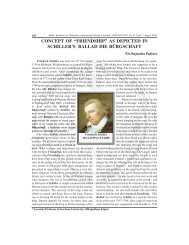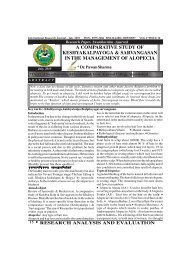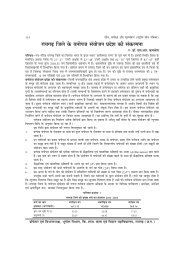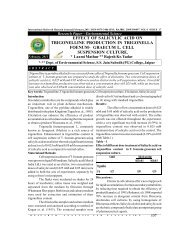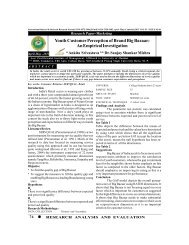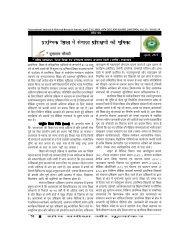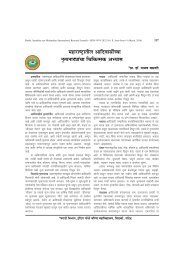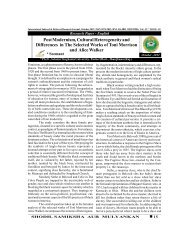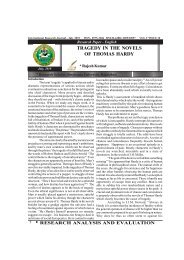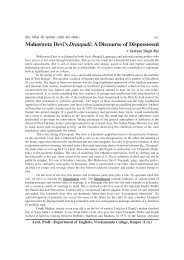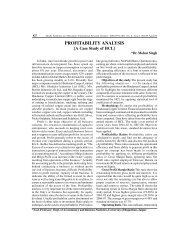Study Of Adolescence In Toni Morrison's"The Bluest Eye"
Study Of Adolescence In Toni Morrison's"The Bluest Eye"
Study Of Adolescence In Toni Morrison's"The Bluest Eye"
Create successful ePaper yourself
Turn your PDF publications into a flip-book with our unique Google optimized e-Paper software.
<strong>In</strong>ternational Referred Research Journal,June,2011,ISSN-0975-3486, RNI: RAJBIL 2009/30097, VOL-II *ISSUE 21<br />
June, 2011<br />
24<br />
Research Paper—English<br />
From the beginning black writers have produced a<br />
literature of social protest and human enlightenment.<br />
We can clearly see that most African-American novelist<br />
of the 20th century are concerned with the plight<br />
of black woman, her position within the family, in<br />
society and the world at large. <strong>Toni</strong> Morrison, one of<br />
the major literary figures in contemporary American<br />
fiction was awarded the Nobel Prize for literature in<br />
1993. <strong>The</strong> central motif of her work is the role of race<br />
in American life. Some of the issues she addresses<br />
include racial discrimination, victimization of the<br />
blacks, the emotional and psychological problems faced<br />
by Afro Americans in trying to achieve a sense of<br />
white cultural codes.<br />
<strong>Toni</strong> Morrison's '<strong>The</strong> <strong>Bluest</strong> Eye (1970), presents<br />
a simple theme: the story of a black adolescent<br />
girl Pecola who wants to "rise up out of the pit of her<br />
blackness and see the world with blue eyes"¹. She<br />
wants blue eyes as a symbol of beauty and therefore of<br />
happiness and tries to set forth Anglo-Saxon standards<br />
of physical beauty and life-style as norms in the<br />
existing society. But Pecola is unable to adopt this<br />
standard and consequently live a life of alienation,<br />
self-hatred and inevitable destruction. She develops<br />
in her as Carolyn Gerald says, "an unfulfilled, insignificant<br />
and negative sense of self."²<br />
<strong>The</strong> novel is narrated by nine years old<br />
Claudia Macteer who is a friend of Pecola but in contrast<br />
to Pecola, Claudia and her sister Frieda Macteer<br />
have confidence in themselves against the harsh realities<br />
of society. <strong>The</strong>y have enough courage to humiliate<br />
light skinned Maureen by calling her "Six-finger-dogtooth-meringue-pie".<br />
Both have a well developed sense<br />
of worth. This has been possible because they have<br />
received both love and feeling of security from their<br />
parents. <strong>The</strong>y are given extra care when they are sick.<br />
Claudia herself says: "And in the night, when my<br />
coughing was dry and tough, feet padded into the<br />
room, hands repined the flannel, readjusted the quilt<br />
and rested a moment on my forehead" Thus MacTeers<br />
love and concern for their children provides them with<br />
security and confidence, which is the basic need for<br />
adolescents in this age. Adolescents have within them<br />
much of the child. <strong>The</strong>y have strong feeling of depen-<br />
<strong>Study</strong> <strong>Of</strong> <strong>Adolescence</strong><br />
<strong>In</strong> <strong>Toni</strong> Morrison's"<strong>The</strong> <strong>Bluest</strong> Eye"<br />
* Mrs. Seemant<br />
* Research Scholor Singhania University , Pacheri Bari, Jhunjunu<br />
dence upon parents and authority figures. But contrary<br />
to it Pecola does not get all this love and concern.<br />
Cholly Breedlove is the head of the Breedlove<br />
family. His psyche is that of an oppressed man. Cholly<br />
has had no family or parents, therefore he knows nothing<br />
about the significance of the family or parentschild<br />
relationship. As a father, Cholly is a total failure.<br />
His mental state is so much confused that he is unable<br />
to understand the feeling he has towards his daughter.<br />
Cholly's yearning for love and his desperate desire to<br />
give love to his daughter ends in his raping Pecola. <strong>In</strong><br />
this manner, Cholly Breedlove, though unconsciously<br />
contribute towards her insanity. Pecola gets a great set<br />
back in her life through this incident. After regaining<br />
consciousness following the rape, Pecola is able to<br />
speak. She tells to her mother, Pauline Breedlove, what<br />
has happened. As Mrs. Breedlove does not want to<br />
hear and does not want to believe, Pecola recognizes<br />
the futility of attempted communication. Thus when<br />
Cholly rapes second time, Pecola keeps the story to<br />
herself; in silence this eleven year old girl steps into<br />
her own personal world of silence and madness. Pecola's<br />
* self" becomes so crazed, so fragmented, that it conducts<br />
conversations with itself and with no one else:<br />
* How come you don't talk to anybody?" * I talk to you."<br />
* Besides me." * I don't like anybody besides you……."<br />
* You don't talk to anybody. You don't go to school. And<br />
nobody talks to you" .<br />
Pauline too does not have a positive sense of<br />
self. She denies the reality of her own family and life.<br />
She neglects her family more and more: "More and<br />
more she neglected her house, her children, her manthey<br />
were like the afterthoughts one has just before<br />
sleep, the early-morning and late evening edges of her<br />
day, the dark edges that made the daily life with the<br />
fishers lighter, more delicate, more lovely". Pauline<br />
attitude makes her daughter Pecola hate her black self.<br />
She plays a pivotal role in turning her daughter's sense<br />
of self-negative. So, Pecola feels excluded from family.<br />
Even her mother fails to see in her daughter the need<br />
of belongingness. <strong>The</strong> need for acceptance,<br />
belongingness and recognition is so pressing in her but<br />
she does not get any response from her family or surroundings.<br />
<strong>The</strong> school children, who shout names at<br />
R E S E A R C H A N A L Y S I S A N D E V A L U A T I O N
<strong>In</strong>ternational Referred Research Journal,June,2011,ISSN-0975-3486,RNI: RAJBIL 2009/30097,VOL-II*ISSUE 21<br />
Pecola, shame her and use her features as a way of<br />
denying her admission into their society. Boys circle<br />
her in a ritual of insult and shout, "Black emo Black<br />
emo ya daddy sleep nekked". <strong>In</strong> the process, Pecola is<br />
given another opportunity to view her status as an<br />
outsider. Her rescue by Maureen Peal, Claudia and<br />
Frieda is only temporary. Maureen insults her by saying<br />
"I am cute! And you ugly! Black and ugly black e<br />
mos. I am cute!" . Conscious of her unattractiveness<br />
and her color, Pecola seems to disappear where she<br />
stands. Children, neighbours and other adults have<br />
confirmed that Pecola will never be an insider in the<br />
black community and cannot possibly hope for acceptance.<br />
Pecola for Geraldine serves as a symbol of<br />
everything ugly, dirty and degrading. Physically as<br />
well as symbolically, Graldine negates Pecola, denies<br />
the ragged eleven year old access to her world. She<br />
says to Pecola, "Get out…………You nasty little black<br />
bitch. Get out of my house" . <strong>In</strong>stead of defending<br />
herself against the humiliation, Pecola backs out of the<br />
room keeping her head downward. <strong>The</strong> most powerful<br />
illustration of Pecola's failure to act occurs in the novel,<br />
when she enters in the shop of a white shopkeeper.<br />
When Pecola looks up she finds only, "the total absence<br />
of human recognition, the glazed separateness"<br />
. Being aware of her ugliness, Pecola is overpowered<br />
by a tremendous sense of shame. She equates herself<br />
with dandelion weeds which she regards ugly and<br />
unwanted like herself. Pecola's belief that the only<br />
escape for her is to become beautiful through obtaining<br />
the blue eyes, the eyes that will dazzle into loving<br />
her. Pecola's wish for blue eyes ties her into an illusion.<br />
She is victimized physically and psychologically by<br />
Cholly Breedlove and Soaphead Church respectively.<br />
Thus, as a black girl, Pecola undergoes all the<br />
traumatic experience she wants to rise up out of the pit<br />
of her blackness and see the world with blue eyes, but<br />
the pity is that she is not allowed to, Pecola's misfortune<br />
is that she is never given the opportunity in any<br />
realm to see anything positive in herself as she is. She<br />
seems doomed whatever she does -if she resorts to<br />
fantasy, she is considered crazy, and if she tries to live<br />
in the real world, there is no place for, this, Pecola fails<br />
in her quest for self. <strong>In</strong>stead of gaining individuality,<br />
ultimately she gets alienated not only from the society<br />
but also from her own self. She fails to get recognition,<br />
it is the first step in being acknowledged, acceptance<br />
R E F E R E N C E<br />
because it is the first step in being acknowledged,<br />
acceptance because it confirms that the self has been<br />
recognized which is one of the prominent need of an<br />
adolescent. Consequently she cowers, shrinks and<br />
resides behind walls of madness.<br />
Thus her family atmosphere and other shattering<br />
experiences make Pecola hate her blackness<br />
and long for white standard of beauty. Pecola as Royster<br />
point out is "the novel's central scapegoat, "³ for she is<br />
made scapegoat by her parents as well as whites and<br />
other light skinned people in the novel.<br />
<strong>In</strong> many ways <strong>The</strong> <strong>Bluest</strong> Eye is similar to<br />
Ralph Ellison's <strong>In</strong>visible Man in its very theme and<br />
structure. "What did do to be so black and blue?" This<br />
question must reverberate in Pecola's mind throughout<br />
her life. Again and again she is confronted with<br />
people who tell her to 'stay back' because of her blackness.<br />
Pecola's fate seems along strikingly parallel lines.<br />
Despite the offerings and incantations of Claudia and<br />
Frieda, Pecola miscarries and remains friendless.<br />
Grown people turn away, children laugh and no stranger<br />
attempts to share Pecola's world. Pecola is violated by<br />
a male relative, ayoung virgin suffers sensual loss to<br />
such an extreme that her very identity is called into<br />
question.<br />
By exploring the devastating effects that the<br />
western ideas of beauty and romantic love have on a<br />
black adolescent girl, this novelist also demonstrates<br />
how these ideas can invert the natural order of an<br />
entire culture. This simple theme is a real and symbolic<br />
statement about the conflict between the good<br />
and the beautiful of two cultures and how it affects the<br />
psyche of the people within those cultures. Morrison<br />
treatment of this adolescent character shows that she<br />
attaches great importance to one's self-acceptance and<br />
inner harmony. Through Pecola she seems to say that<br />
at this age peer group and family hold a major importance<br />
in adolescents' life because they have no way to<br />
support themselves outside the family. <strong>The</strong> need for<br />
acceptance, belonging and recognition is so pressing<br />
that adolescents constantly look from the vantage point<br />
of those they are trying to impress. <strong>The</strong>y think about<br />
appearance, they evaluate their social performance.<br />
But the novelist stresses the fact that one's distorted<br />
self, whether caused by one's own limitations, family<br />
or environment, leads to one's destruction; while one's<br />
balanced psychology and honest acceptance of life can<br />
lead to a more fulfilling survival.<br />
¹<strong>Toni</strong> Morrison, <strong>The</strong> <strong>Bluest</strong> Eye (1970; rpt. London: Vintage, 1999), p.138. (All subsequent references to the novel are from the same edition<br />
and page numbers in all such cases are within parenthesis, following the quotations). ²Carolyn Gerald, quoted by Wilfred D, Samuels, "<strong>The</strong><br />
Damaging Look: <strong>The</strong> search for Authentic Existence in <strong>The</strong> <strong>Bluest</strong> Eye, "<strong>Toni</strong> Morrison, (Boston, Massachusetts: Dwayne Publishers, 1990),<br />
p.10.³Royester, quoted by Wilfred D, Samuels, "<strong>The</strong> Damaging Look: <strong>The</strong> search for Authentic Existence in <strong>The</strong> <strong>Bluest</strong> Eye, "<strong>Toni</strong> Morrison,<br />
and p.14. 4Ralph Ellison, <strong>In</strong>visible Man (New York: Random House, 1972).<br />
R E S E A R C H A N A L Y S I S A N D E V A L U A T I O N 25



